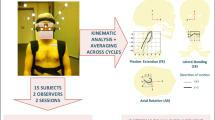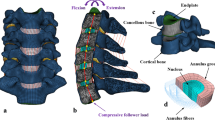Abstract
Cervical spine motion was investigated by three-dimensional electrogoniometry in 257 asymptomatic volunteers and in 32 patients with cervical disc hernia or whiplash syndrome. Maximal ranges of main and coupled motions were considered. Motion curves were analysed qualitatively and using fitting of sixth degree polynomials. Motion ranges obtained were in agreement with previous observations. Significant differences between patients and volunteers concerned several primary and coupled components but not all. Qualitatively, patients displayed less harmonic curves, with irregularities and plateau-like appearances. Root mean square differences between data and fit were significantly modified in patients. Although cervical spine motion ranges may remain within normal limits in patients, motion patterns were altered qualitatively and quantitatively. Motion pattern analysis might prove a useful discrimination parameter in patients in whom anatomical lesions are not clearly identifiable.
Résumé
Les mouvements cervicaux ont étéétudiés par électrogoniométrie tridimensionnelle chez 257 volontaires asymptomatiques et chez 32 patients (hernie discale ou TAEC). Les amplitudes maximales des mouvements principaux et couplés ont été considérées. Les courbes de mouvement ont été analysées qualitativement et par ajustement polynomial du sixième ordre. Les amplitudes de mouvement étaient en accord avec les observations antérieures. Des différences significatives entre patients et volontaires concernaient plusieurs composantes prin-cipales et couplées, mais pas toutes. Qualitativement, les patients présentaient des courbes moins harmonieuses, avec des irrégularités et des apparences en plateau. Les écarts quadratiques moyens entre les données et l’ajustement étaient significativement modifiés chez les patients. Bien que les amplitudes de mouvement puissent rester dans les limites normales chez les patients, les schémas de mouvement étaient qualitativement et quantitativement altérés. L’analyse des schémas de mouvement pourrait s’avérer être un paramètre de discrimination utile chez les patients chez qui les lésions anatomiques ne sont pas clairement identifiables.
Similar content being viewed by others
Author information
Authors and Affiliations
Additional information
Accepted: 20 June 1999
Rights and permissions
About this article
Cite this article
Feipel, V., Rondelet, B., LePallec, J. et al. The use of disharmonic motion curves in problems of the cervical spine. International Orthopaedics SICOT 23, 205–209 (1999). https://doi.org/10.1007/s002640050351
Issue Date:
DOI: https://doi.org/10.1007/s002640050351




